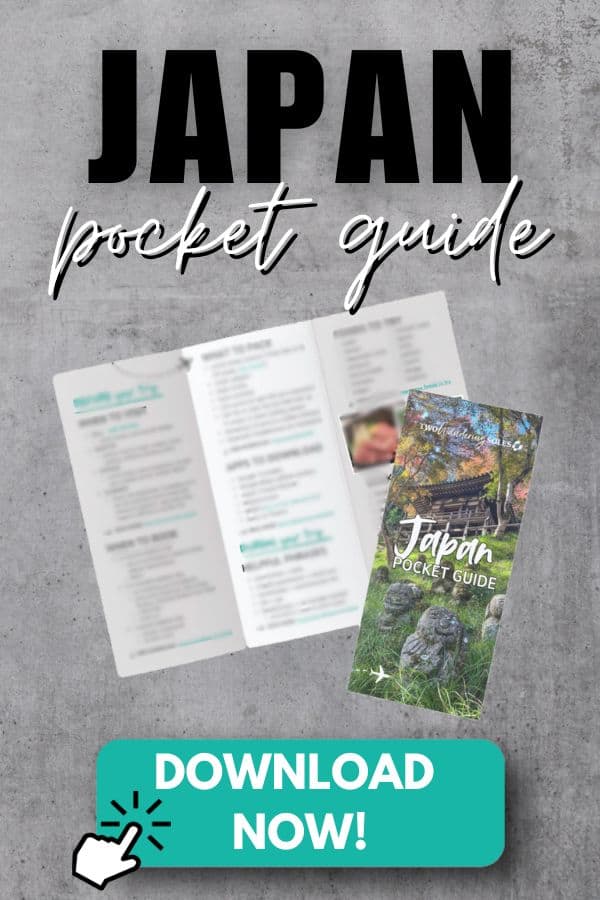In this article we’re covering essential tips for visiting Japan, plus helpful advice we learned from personal experience that’ll ensure you enjoy your time in the Land of the Rising Sun even more!
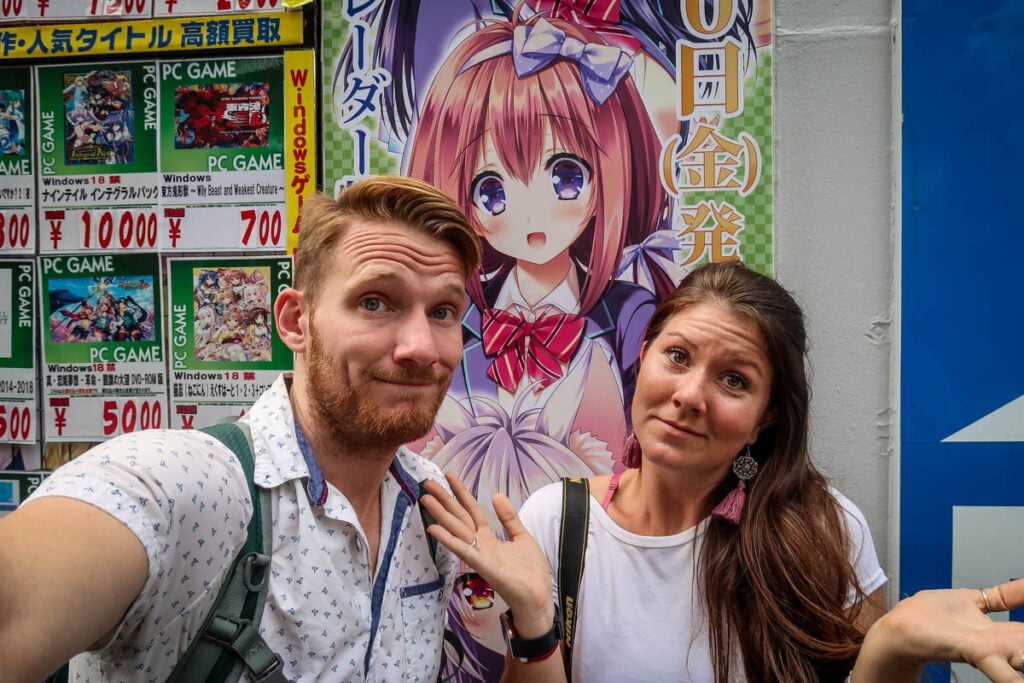
Before you hop on that flight to Japan, there are some things you should know.
This country has a complex culture, and there are definitely some manners and “norms” you should be aware of. There are also some Japan-isms that will leave you scratching your head… like, what are all those buttons for on Japanese toilets anyway?!
Don’t worry, we’ll give you the scoop!
We’ve traveled to Japan three times now (and counting!) and have picked up some pretty good travel tips along the way. In this article we’re going over the essential tips for visiting Japan you should know before you go.
Let’s jump right in…
1. Don’t worry too much about the language barrier
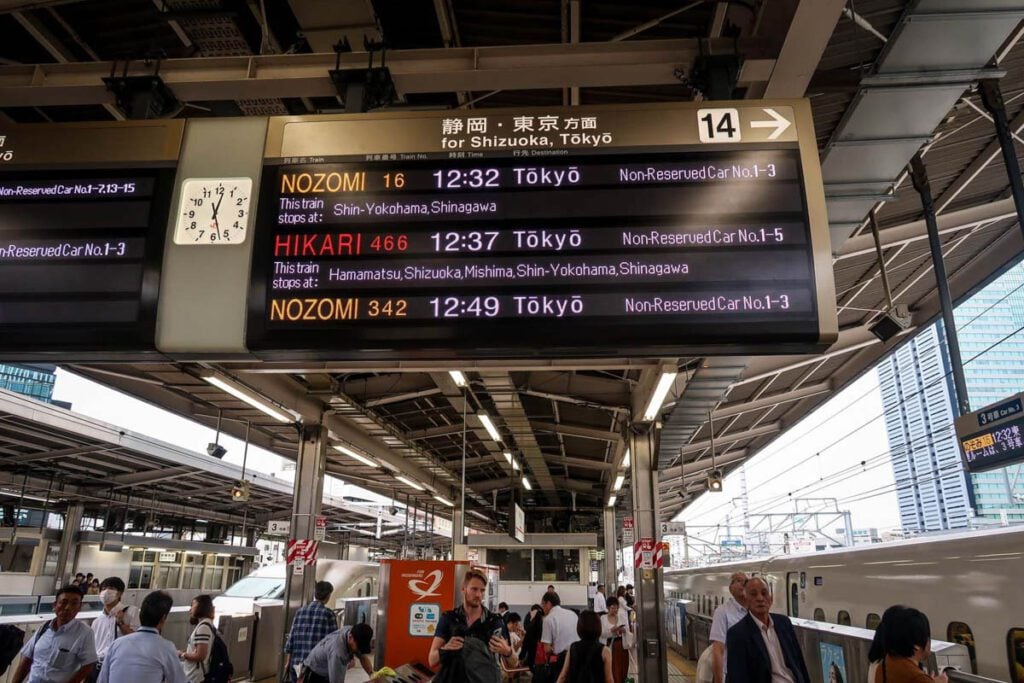
One of the things we get the most questions on is the language barrier in Japan. And after reading guide books and articles online, it can seem like traveling in Japan without speaking Japanese is impossible. But that’s far from the truth.
Honestly, we didn’t feel like the language barrier was too bad. (That said, we’ve spent a cumulative 3+ years living in and traveling through Asia, so we are used to language barriers.)
It is always respectful and recommended that you learn a few helpful words or phrases in the country you’re visiting, but we want to point out that it is possible to have a fantastic trip to Japan without having mastered the language.
This should put you at ease:
- All major signage in train stations is in Japanese and English
- In the event that you have a question, go to the JR counter and speak to an employee. They should have a translation device, which will help in the event that they aren’t confident with their English skills.
- Oftentimes restaurants have English menus (some even have pictures!)
- Hotel staff usually speak a bit of English
- At most restaurants there is at least one staff member who will be able to communicate with English speakers
- Oh, and the Google Translate app is literally the BEST THING EVER. Read about more apps we recommend downloading for your trip to Japan!
- Japanese people, in general, are very polite and kind. While they may not approach you, if you ask for help they will usually do their best to assist you or point you in the direction of someone who can help.
Learn a few words in Japanese, as it will show you’re trying. And be patient. Remember, you are a guest in another country, and while some people may know a bit of English, it is not their first language.
Helpful words & phrases in Japanese
- Hello: Konnichiwa (also means “good afternoon’)
- Good morning: Ohayō gozaimasu
- Thank you: Arigato gozaimasu (the “u” on the end of the word is almost silent)
- Excuse me: Sumimasen
- Cheers!: Kanpai!
- Delicious: Oishī
- → More practical Japanese words and phrases
If you take one thing away from this point, I hope that it’s this:
There will be a language barrier while traveling in Japan, and you can’t expect people to speak English. BUT, it is definitely possible to communicate with simple vocab words, the Google Translate app, and a bit of patience.
2. Japan is super safe
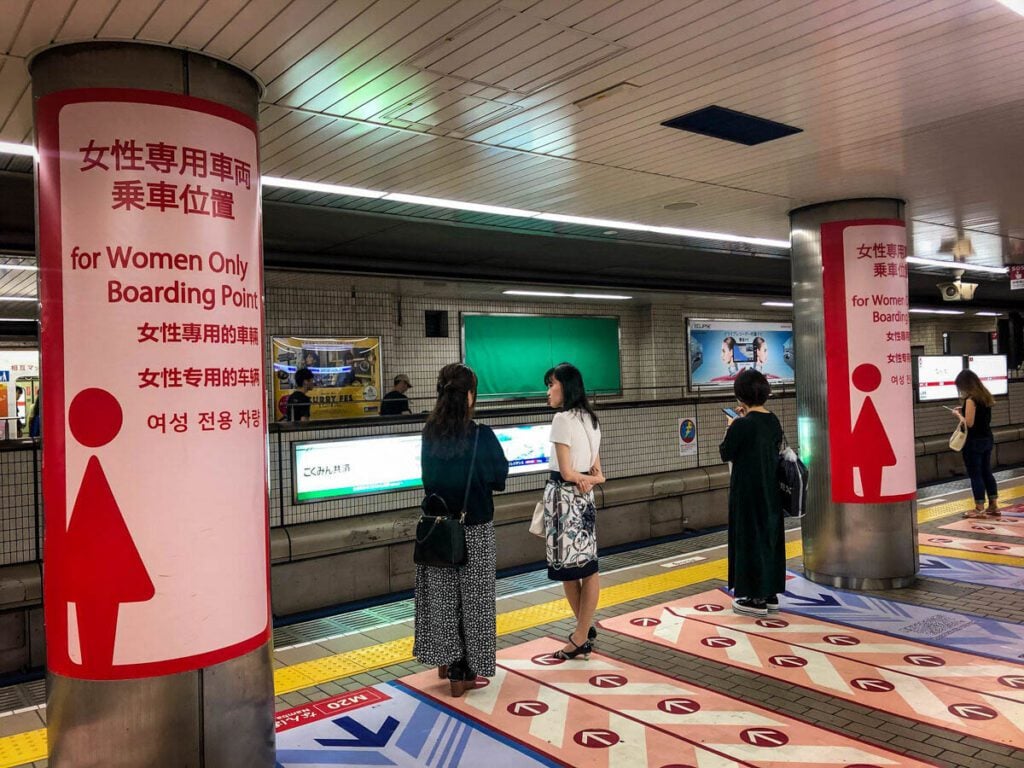
Like, very safe. Of course, you’ll still want to use common sense on your travels in Japan, but the chances of you encountering any dangerous situations or theft are very slim.
We’ve known people who have left their wallet on a crowded subway in Tokyo, only to have it hand-returned to them hours later. The thing we had to get used to was being mindful of our belongings when we returned to the U.S. after our trip to Japan!
→ Psst! Here are some essential travel safety tips you should know before any travels!
3. Do look into getting a Japan Rail Pass to save money
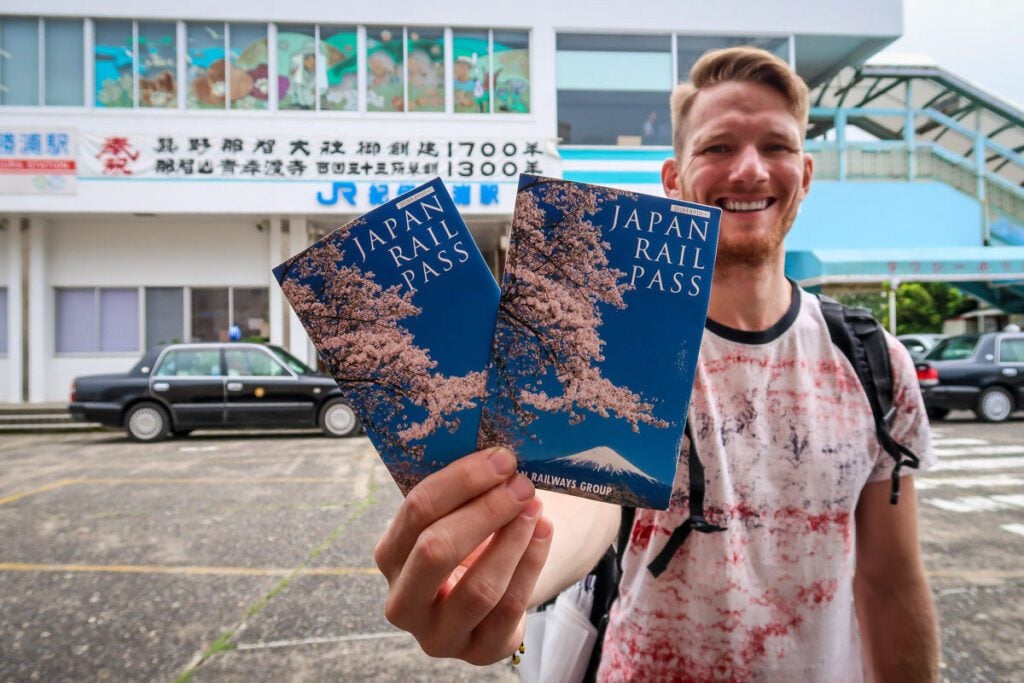
Essentially, if you plan to visit more than 2 cities during your trip to Japan, the JR Pass will almost definitely save you money.
We have a whole article detailing it and even a quick way to calculate whether or not it will be worth it for you… but chances are it WILL.
Also, we didn’t know this until we were in Japan, but Japanese citizens actually cannot get this pass, and therefore pay a lot more than most tourists for train travel.

4. Book your major train routes ahead of time

Many popular routes get fully booked up, so don’t wait until the last minute to reserve seats. For example, we had to stand for the 1.5-hour ride from Hiroshima to Osaka because we didn’t book our tickets in advance.
When you have the JR Pass, all train routes are free (there are a few lines that are not included, but you really don’t have to worry about those).
We’d recommend on your first day in Japan, to go to the JR ticket counter at the train station and reserve all your seats for your routes at once. You can always change your time and book another ticket later, but it’s good to have seats reserved.
If your route is fully booked, on every shinkansen train (bullet trains) there are a couple of cars that are for passengers that don’t have reserved seats. However, there is a high chance that you’ll be standing for that ride.
5. Do eat more than sushi and ramen
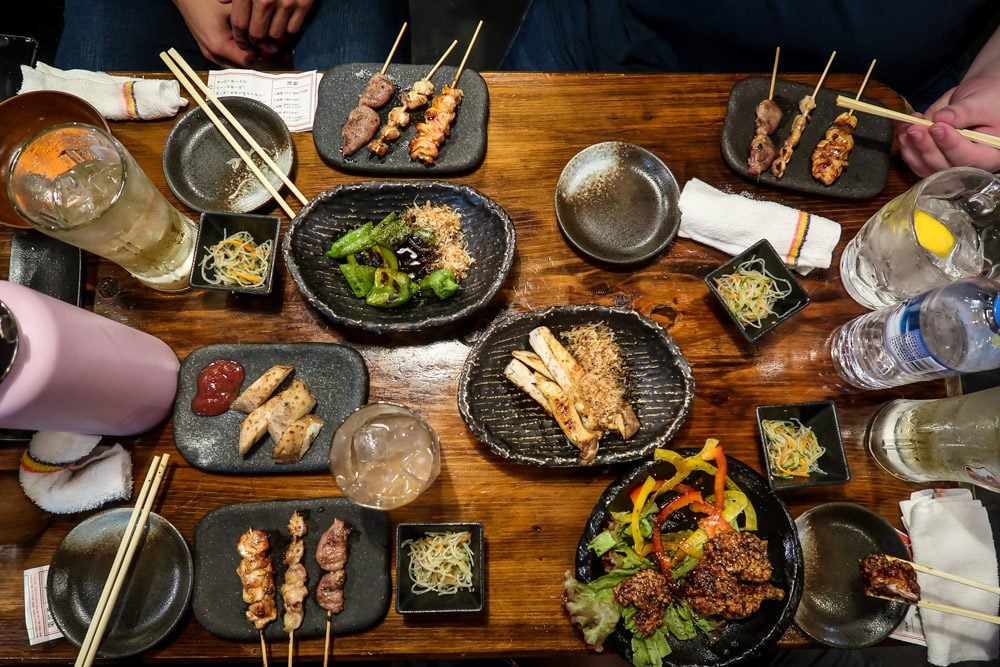
Before our first trip to Japan, our knowledge of Japanese cuisine started and ended with sushi and ramen. We didn’t know much else about it. But we’re here to tell you there is SO much more to this cuisine.
Check out our guide to the best foods to try in Japan, which even has a checklist you can download so you can make sure you don’t miss any foods! The more you know before your trip, the more you’ll be able to try.
6. Mind your manners
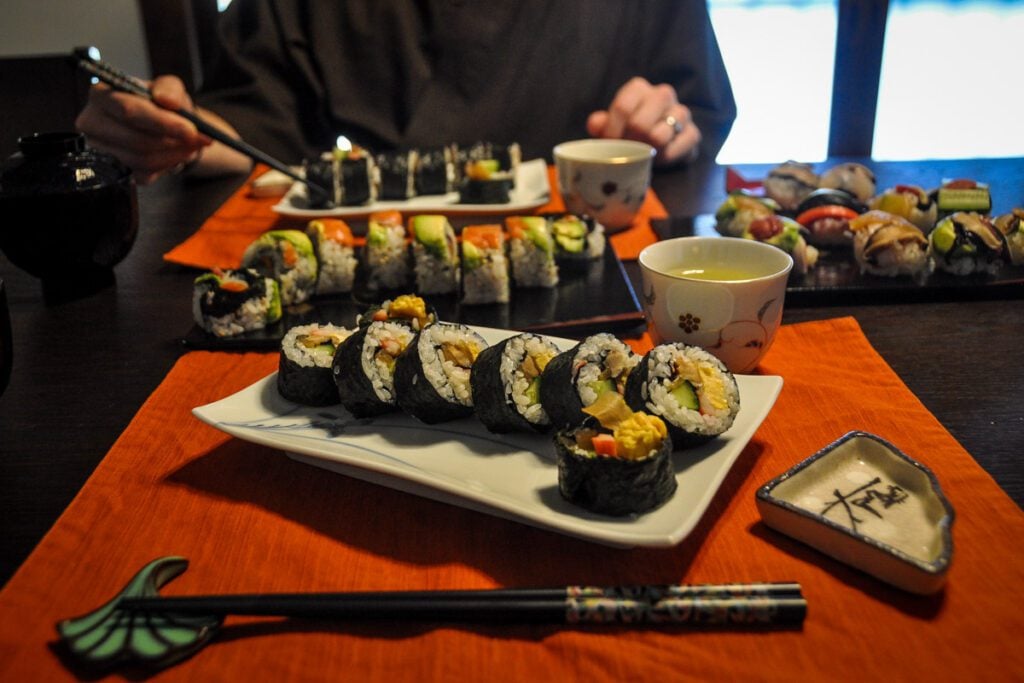
Manners are important in Japan, and it’s a good idea to read up on some Japanese etiquette before your trip so you don’t embarrass yourself or offend someone.
Here are a few manners to keep in mind:
- Instead of pointing with one finger, use your entire hand
- Avoid physical touch, like hugging, until you know if someone is comfortable with it. Also, public PDA is kind of a no-no
- Don’t eat while walking
- Be quiet on public transportation and avoid taking phone calls if possible
7. Don’t tip your server
While it is a common practice in North America, Europe and many other parts of the world, tipping is not part of Japanese culture and can be seen as mildly rude in some instances.
The Japanese believe that good service is expected (whether it be at a restaurant or tour) so there is no need to add extra money in the form of a tip.
Try to show your appreciation for a meal or tour by verbally thanking the staff, cook or guide. Leaving a review is always helpful so other travelers know what to expect.
8. Forks are few and far between
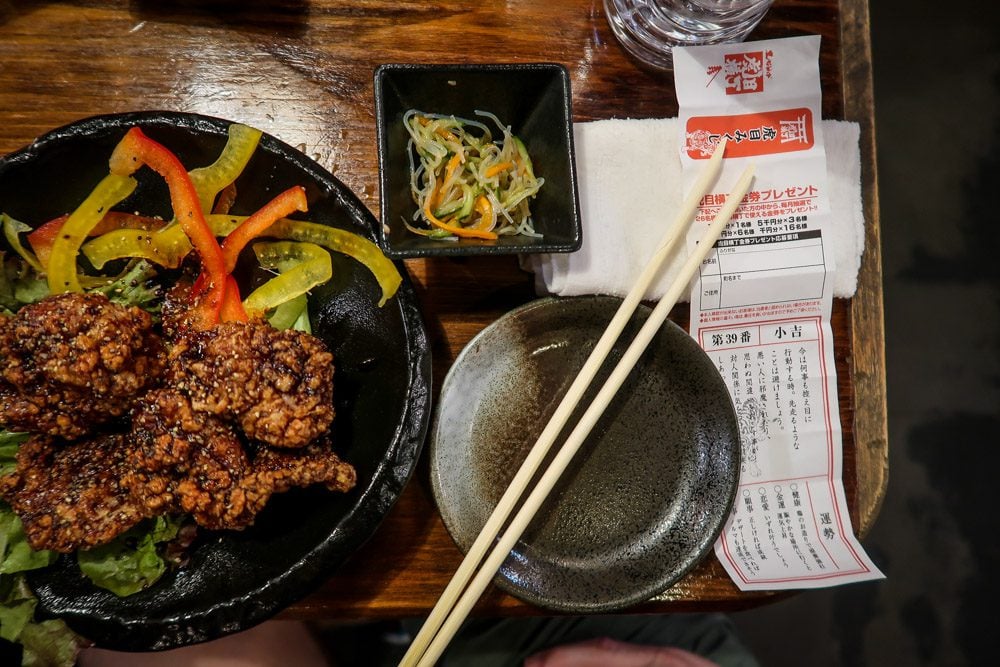
You’ll want to practice your chopstick skills before your trip to Japan because it is the utensil of choice, and very rarely will you find forks.
Hint: Chopsticks also make a great souvenir from Japan!
9. Do slurp your noodles
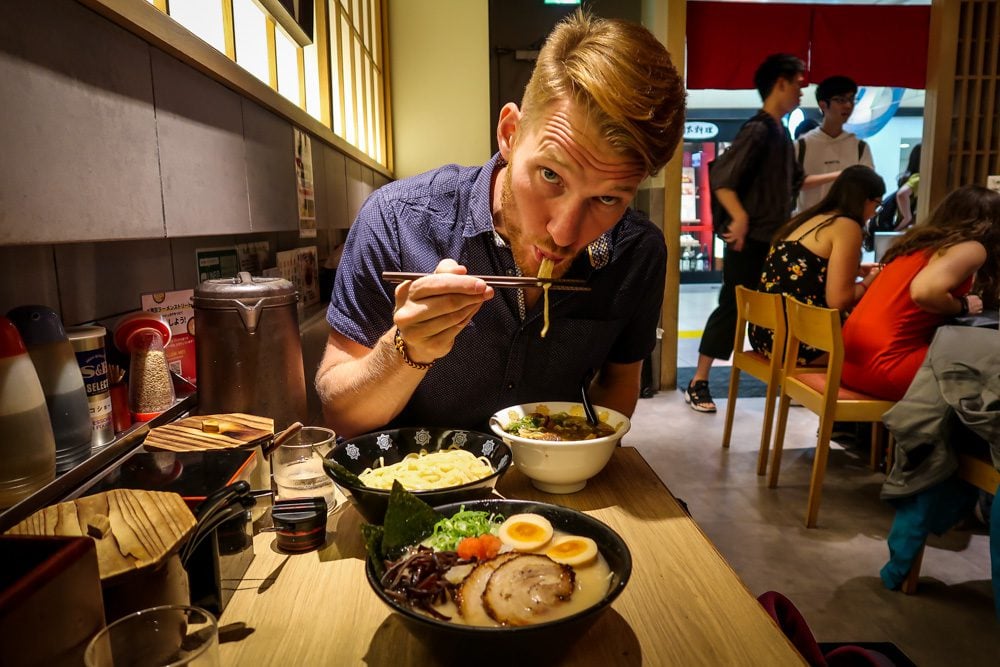
Everyone knows that slurping noodles is the best way to enjoy them, right? Well, here’s a fun fact about Japan you didn’t know you needed: it’s actually not considered rude!
In Japan, slurping your noodles is actually considered a sign of appreciation. It shows the restaurant or chef that you’re enjoying their food. Plus, slurping can even enhance the flavor!
10. Don’t forget to take your shoes off
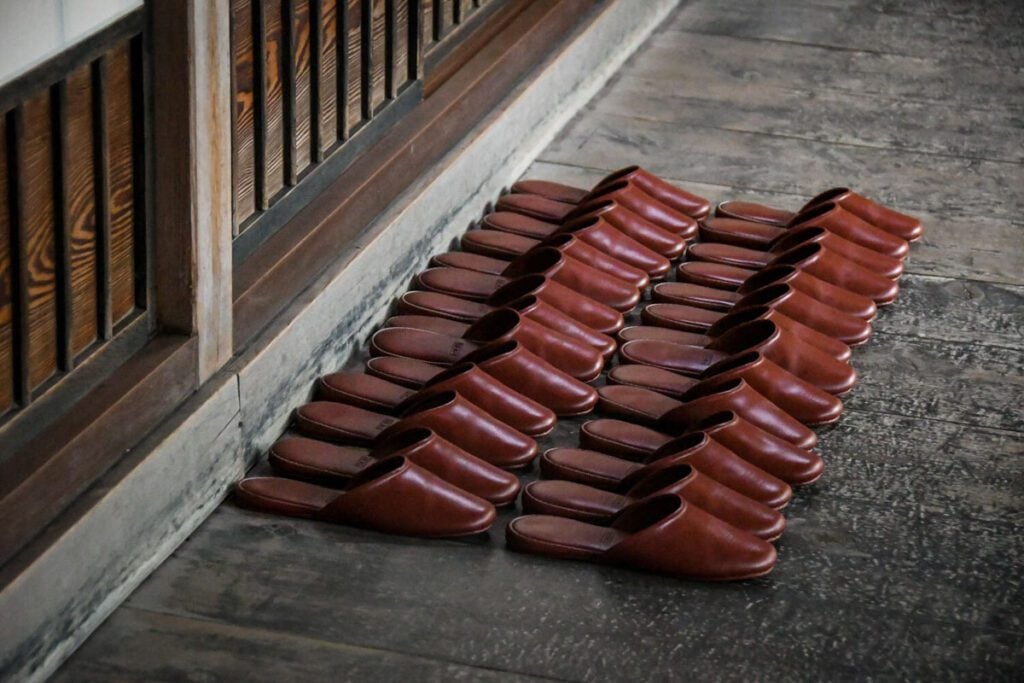
When entering guesthouses, homes, holy sites, and some stores, you will need to remove your shoes. This is typically indicated by floor that is different levels — either raised or lowered once you enter.
Usually there are indoor slippers that you can wear once you remove your shoes. The exception to this is in rooms where the floor is tatami mats — a delicate traditional flooring made of rice straw. These are common in traditional guesthouses and teahouses, inside which you can wear socks.
Also, some guesthouses have bathroom slippers. Yes, you read that right, shoes for the potty. Typically they will be sitting just inside the bathroom door and you’ll leave your indoor slippers outside of the bathroom.
11. Do learn onsen etiquette
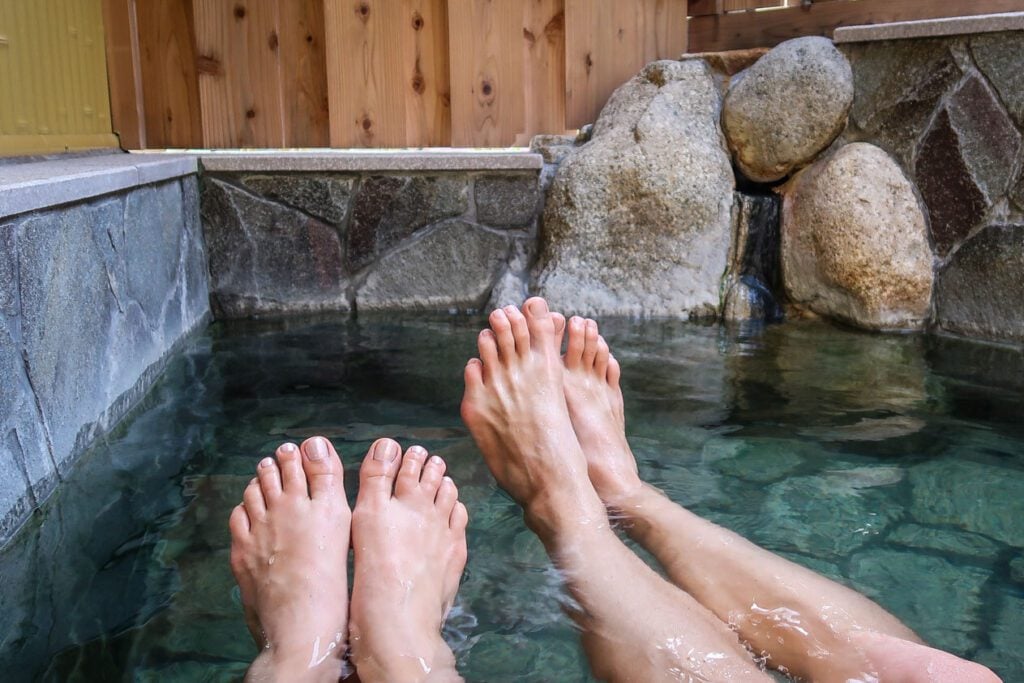
Soaking in an onsen should definitely be on your list of top things to do in Japan!
Hold up, what is an onsen, exactly?
An onsen is a Japanese hot spring with a bathing facility.
Japan has a lot of volcanic activity, meaning there are many onsens to choose from all around the country!
But before you start shedding your clothes, there are some important rules you should know so you don’t embarrass yourself. We’ve put together an onsen etiquette guide to help you avoid some common mistakes.
Alternative: For those of you who just can’t get over the whole naked in public thing (I get it!), you may want to consider staying at a ryokan with a private onsen. This means you can reserve a time slot for yourself (and a travel partner if you wish).
11. Understand the difference between a shrine and a temple
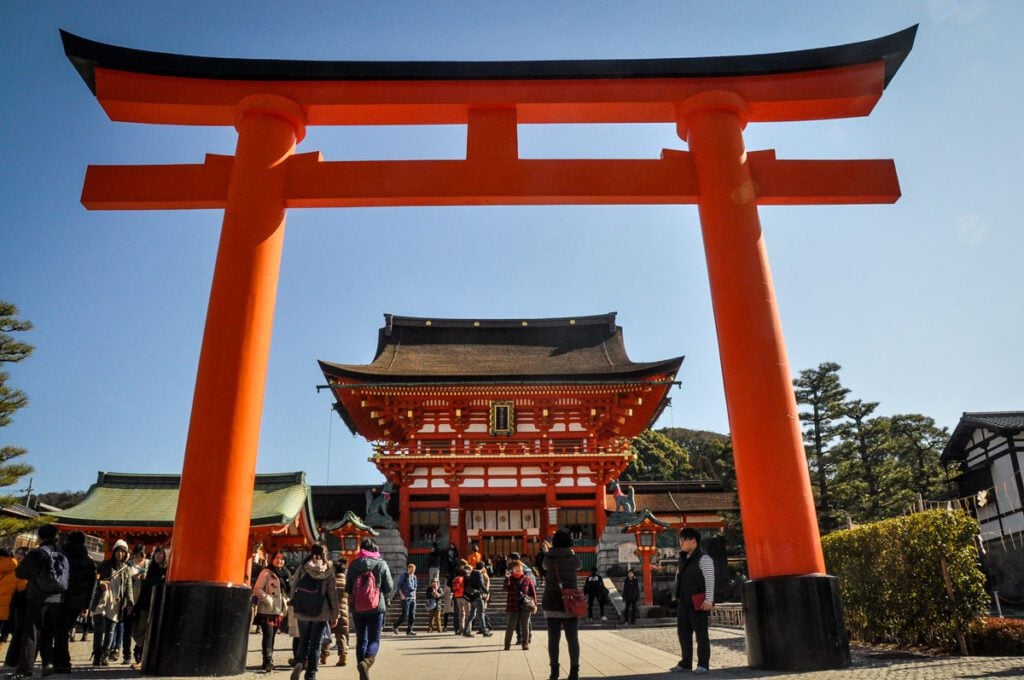
Before traveling to Japan, it’s very useful to know the difference between a shrine and a temple. Here is a general guide to help you:
Shinto Shrine:
- recognize them by the tori gates
- purification fountain (called chozuya) with ladles
Buddhist Temple:
- large incense burner
- statues of Buddha
- sometimes a graveyard is attached
We have a whole section on how to visit a shine and a temple in our Japanese etiquette article.
12. Japan is not as expensive as you might think
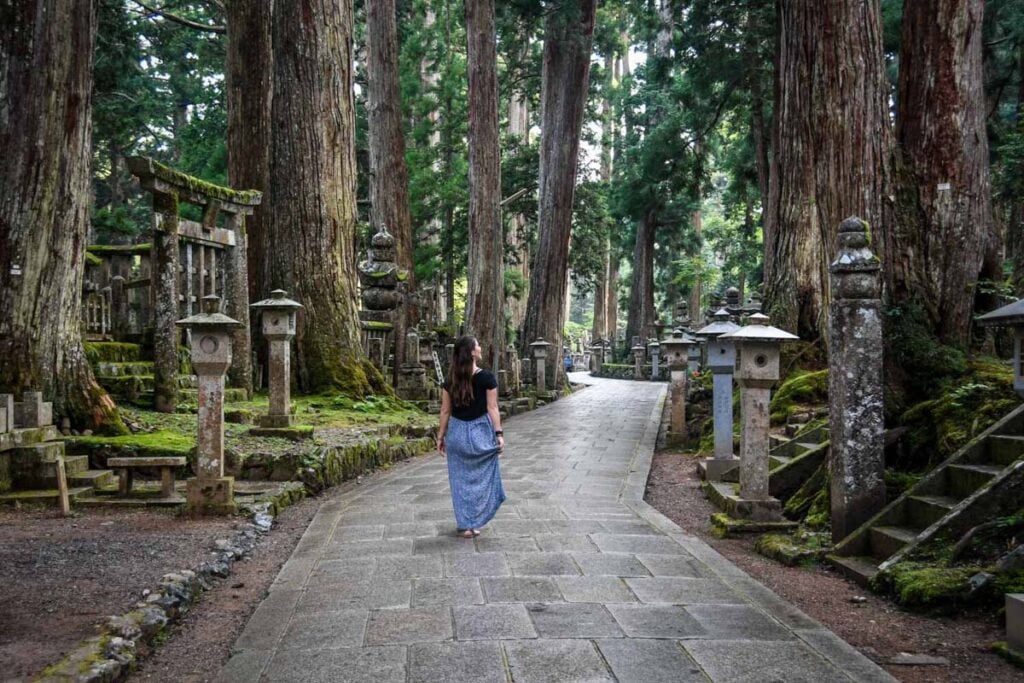
We’ve traveled extensively around Asia, and it’s true — Japan is one of the more expensive places we’ve visited in this region of the world. That said, it is still possible to travel Japan cheaply.
You can find budget accommodation in hostels, capsule hotels, or even Airbnbs. You can save money on food by eating at convenience stores, cooking some meals yourself, and planning out “splurge meals”. Cut transportation costs by getting the JR Pass, and enjoy all sorts of free things to do around the country.
Traveling to Japan doesn’t have to be crazy expensive. We’ve rounded up some of our top tips for traveling to Japan on a budget.
Moral of the story: If Japan is a country you’ve been dreaming of visiting, don’t let costs inhibit or deter you from making your dream a reality!
→ Related: We’ve got tons of super practical tips to show you how we afford to travel!
13. Do carry cash AND credit cards
Many places in Japan accept foreign credit cards with no problem. And if you have one with no foreign transaction fees that earns good rewards, you’ll definitely want to bring it along and use it as much as possible.
That said, there are still small shops, restaurants, and even guesthouses that only accept cash, so you’ll definitely want to have some Japanese yen on hand.
14. Withdraw cash from 7-eleven ATMs
The ATMs in 7-elevens are the most reliable ATMs in Japan with no fees for international cards. As a bonus, you can find 7-elevens everywhere! However, it’s good to note that some of the 7-eleven ATMs in popular spots do now charge a fee, so try to withdraw in less touristy areas.
Insider Tip: We always get foreign currency by withdrawing from ATMs, as it gives you the best exchange rate. To avoid those pesky ATM fees, we use our Charles Schwab debit card, which reimburses all ATM fees at the end of each month. It is the BEST card ever! Read more about which travel credit cards we recommend.
15. Don’t throw out your coins
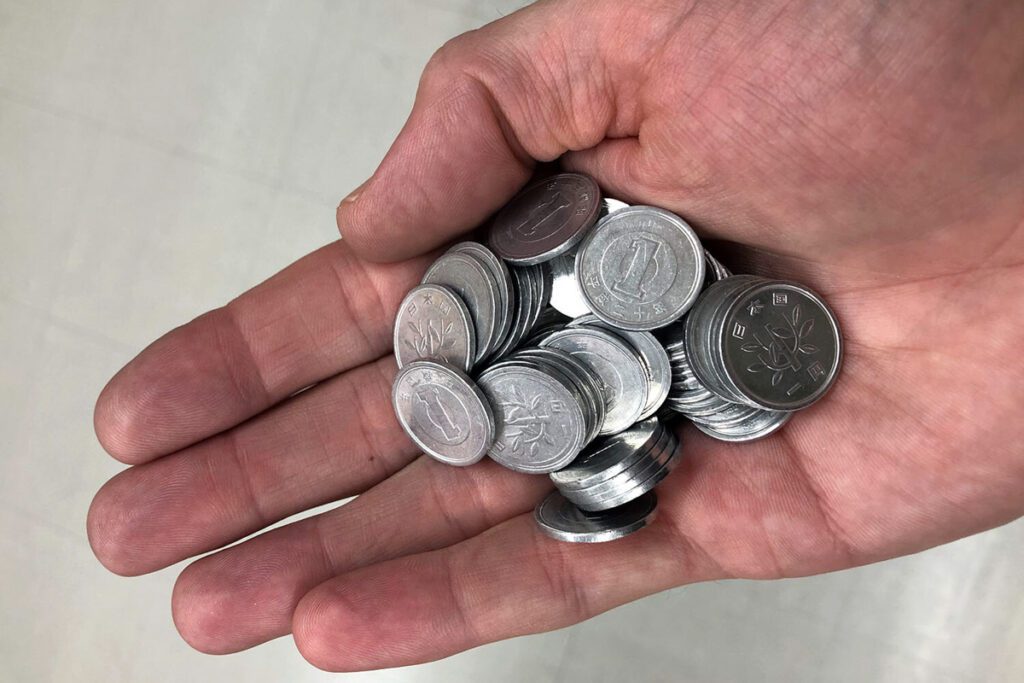
Some of those yen coins are worth almost $5 USD! I don’t know about you, but I typically throw coins around without much care — I mean, it’s no big deal if I misplace 12 cents… But in Japan, losing a handful of coins could add up to big money.
While on a train, a bunch of coins fell out of Ben’s pocket and we had to get down on our hands and knees to find them all before our stop. When we counted them all up we realized we nearly lost $24 USD in coins. Yikes!
When traveling in Japan it’s a good idea to have a coin case to keep them secure.
Tip: We met another traveler who had two coin purses — one for the large coins and one for the small ones to keep them organized.
16. Don’t get lost
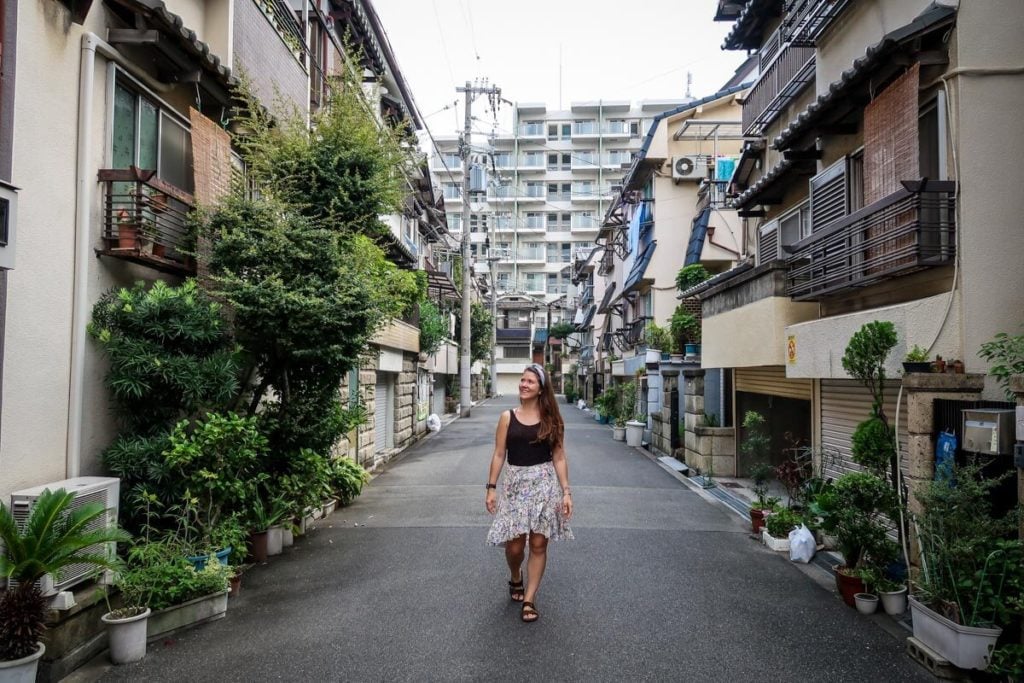
If you’re someone who’s not great with directions, you may find it alarming to find out that streets don’t have names in Japan… So how the heck are you supposed to find your way around?!
Although there are no street names, it isn’t a free-for-all. Addresses in Japan use an area-based system, where each area is divided into smaller areas.
The largest of these is called a prefecture. Prefectures are broken down into cities, and the cities are divided into wards.
Getting around and following directions in Japan is definitely a learning curve, so it’s worth studying some maps and taking time to research the numbering system before visiting.
17. Hold onto your trash
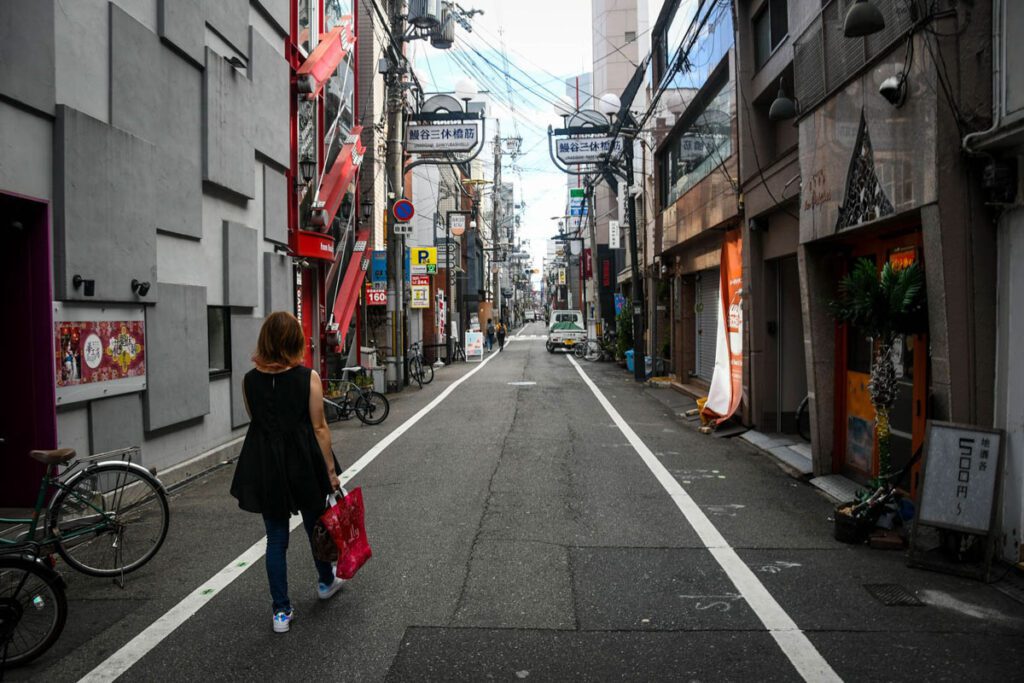
There are few trash cans on the streets in Japan. After hearing this, you might be surprised to learn that even though there is a shortage of garbage bins, there is very little litter in Japan.
Cleanliness is a big part of Japanese culture, which is reflected in the (mostly) litter-free streets.
So do as the Japanese do, and hold onto any wrappers until you find a bin. There are typically trash cans at convenience stores, meant for customers to dispose of their garbage.
18. Do the work to avoid plastic waste
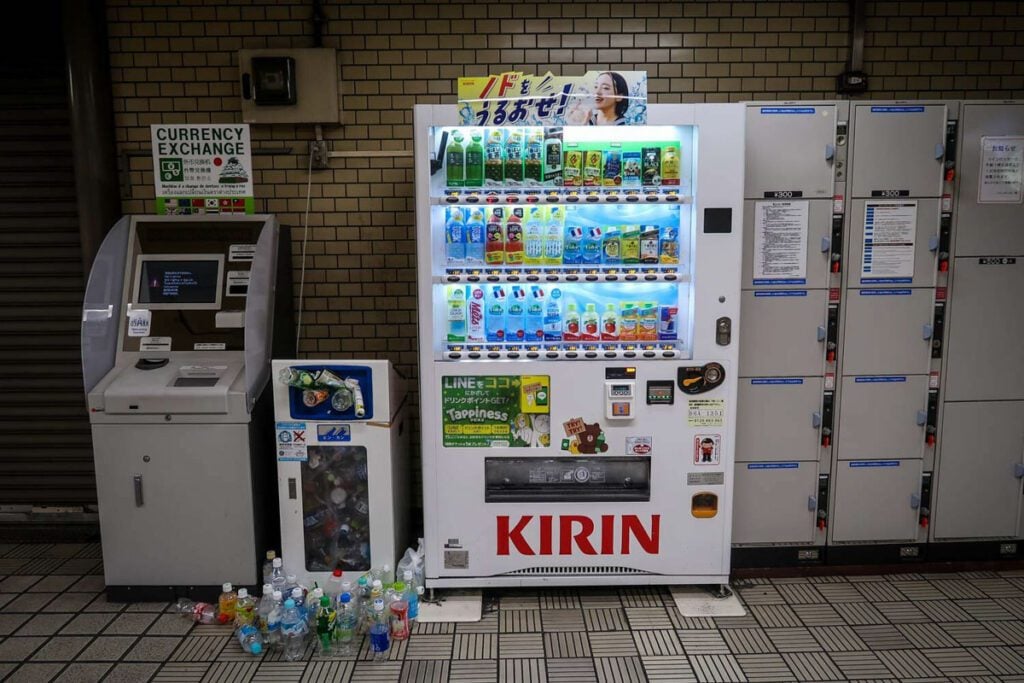
On the surface, Japan seems to be environmentally conscious: there are recycling bins every so often and the streets are very clean.
But as soon as you stop into a convenience store, you’ll notice that this country, like much of Asia, relies heavily on plastic packaging. And the super unnecessary kind, like plastic wrappers around single bananas.
As a traveler, there’s not too much you can do to change this, but you can reduce your own plastic waste by packing items that’ll help you turn down single-use plastic items.
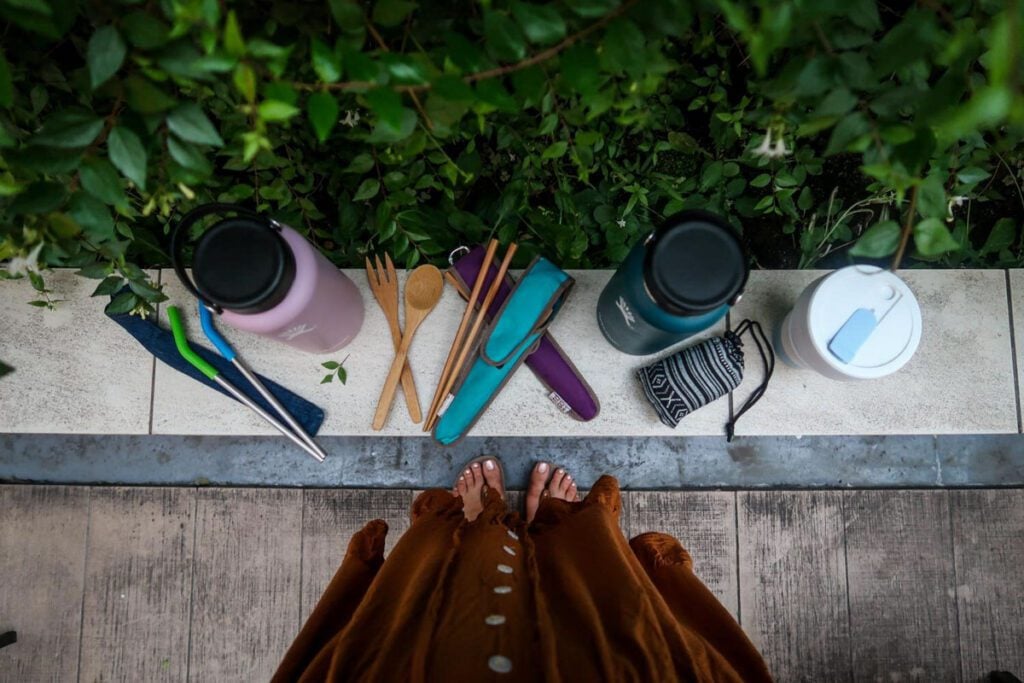
Here are some items we’d recommend packing:
*Yes, you can fill up from the tap and drink the water in Japan! There’s an app called MyMizu that has a map of refill stations (mostly in larger cities, but I’m sure they’re expanding it as data is available).
→ Check out our eco-friendly packing list for some more ideas!
19. Choose an interesting hotel option
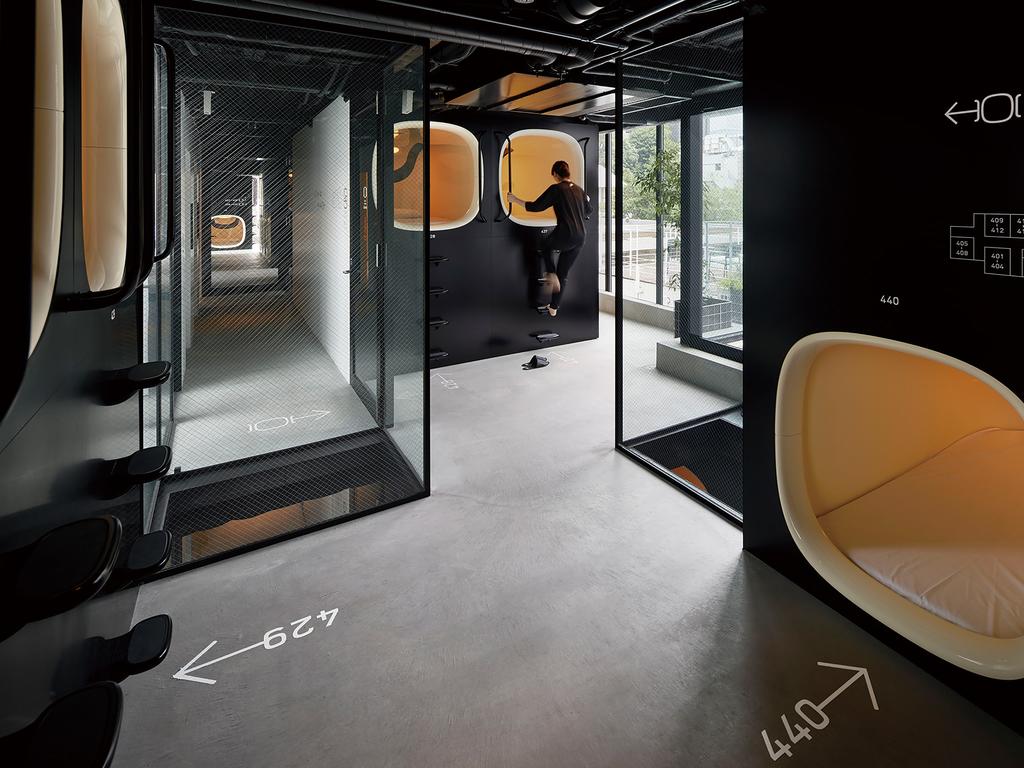
While traveling in Japan, you might want to try out a few unique hotel stays that you can find only in Japan.
- Ryokan: This is a traditional Japanese inn that typically provides guests with robes and meals. There is often a shared bathroom and onsite onsens that can be used by guests.
- Capsule Hotel: Made to maximize space in crowded cities, capsule hotels provide guests with privacy and an affordable stay. However, don’t expect to stand up in your pod! Staying in a capsule hotel is definitely a top Japanese experience to try out on your trip!
- Robot Hotel: There are even hotels run by robots! Like we said, #OnlyInJapan
20. Learn how to use a Japanese toilet
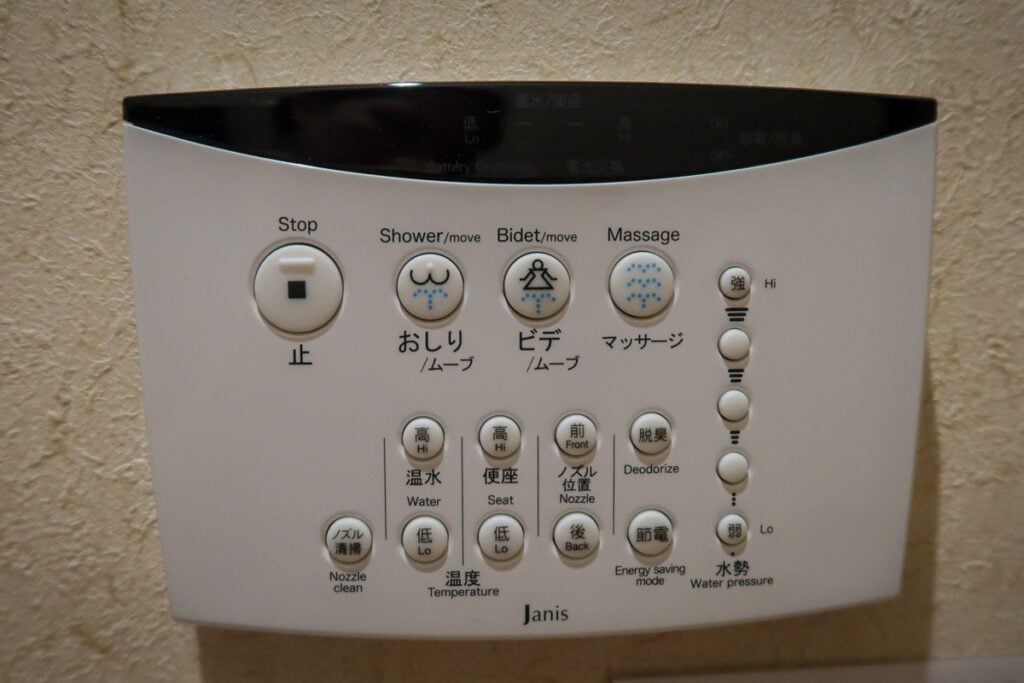
You’ve probably heard about Japanese toilets, and what the rumors say is true!
There are all sorts of buttons that perform different functions. For example, one button may play waterfall sounds or music to cover up—ehem—some other sounds you may not want the person in the next stall to hear. Other buttons will trigger a bum wash and can be set at varying pressure strengths.
All those buttons can be a little intimidating at first, but try them out (locate the STOP button first) and take advantage of those fancy toilets while you can. Because you surely don’t have those fun features at home!
21. Download these apps before you get to Japan
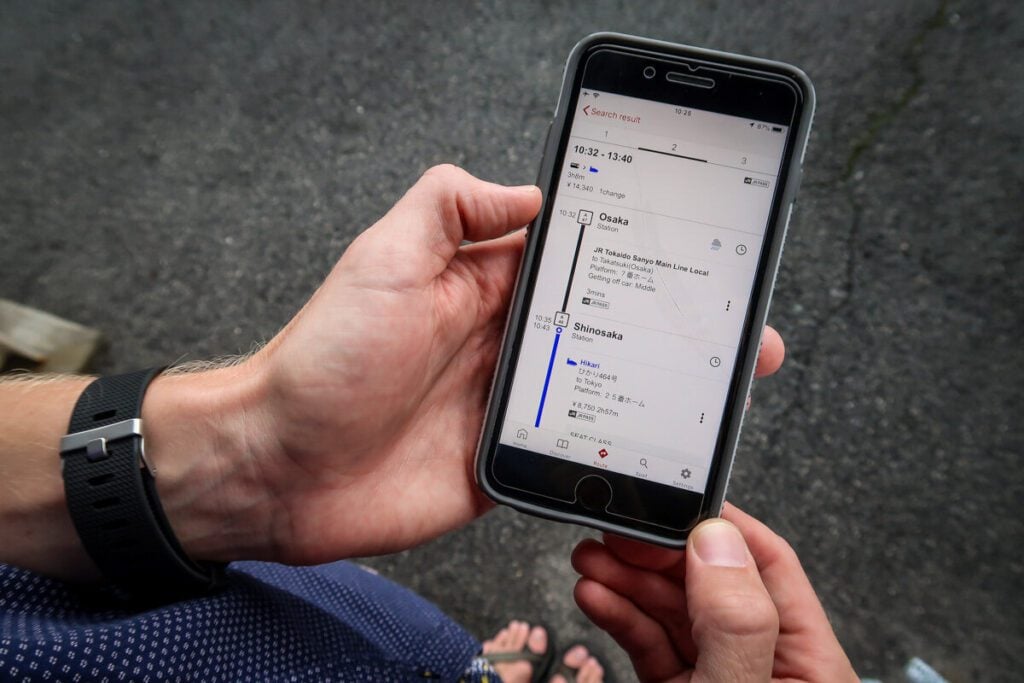
We have a whole article detailing all the best Japan travel apps you should download before your trip, but the 2 best ones that you NEED to download are:
- Japan Official Travel App
- Google Translate
You will thank us because they will come in so handy during your trip!
22. It’s difficult to be gluten-free in Japan
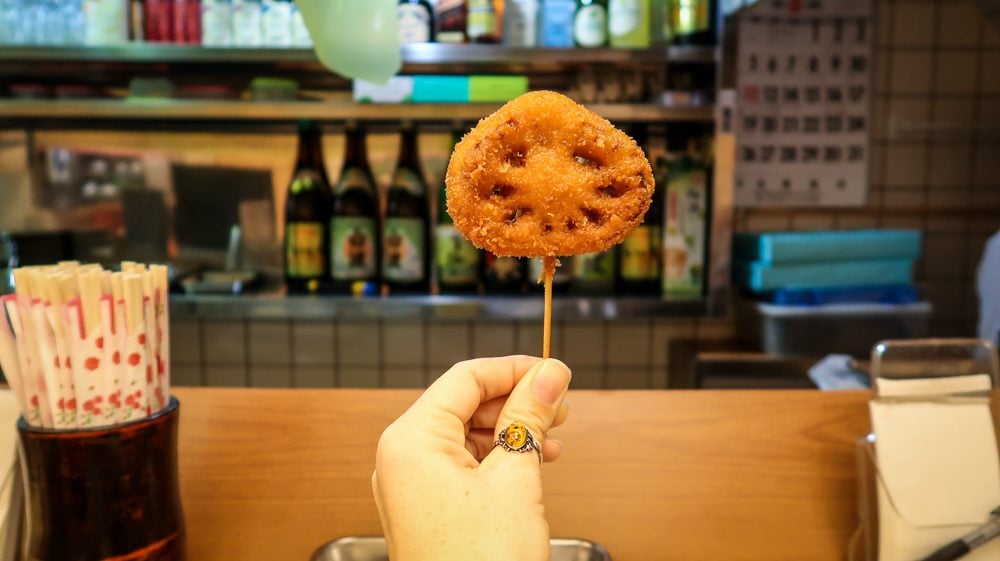
While the abundance of rice may make you think Japan would be an easy country for gluten-free travelers, that’s simply not the case. Soy sauce and other wheat-based seasonings are an integral part of Japanese cuisine, making it hard to avoid gluten.
→ Read this for more info on gluten-free travel to Japan.
23. Be on time
In Japan, it is seen as rude to be late, and thus, everything in Japan is run very strictly according to the clock.
This means trains leave exactly as scheduled and guests are often asked to show up to guided tours 15 minutes in advance. If you have a tendency to be late (I’m right there with ya!), be sure to pay extra careful attention to the time during your trip to Japan.
24. Utilize coin lockers to make things easy
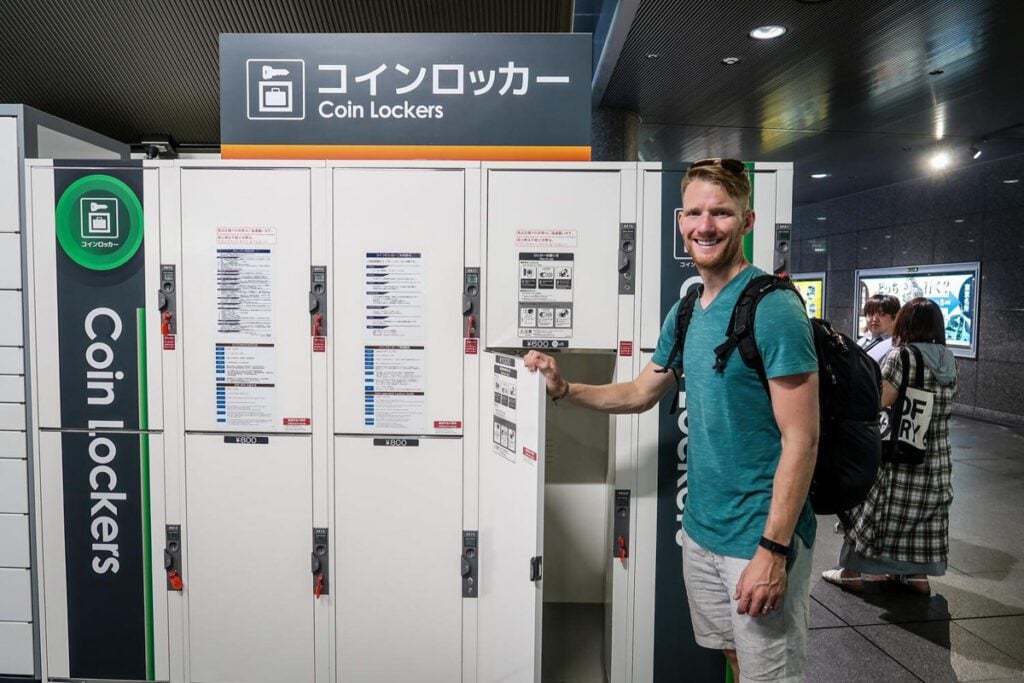
Nearly every train station has lockers which you can use to store belongings for a reasonable price. There are usually different sizes available, so you can store anything from a purse or small daypack to a large suitcase.
This is handy when you need to check out of your hotel but want to spend the day exploring.
Insider Tip: If you have a suitcase that you don’t want to bring with you on the train, there are luggage transport companies that can get it to your final destination for you!
25. Theme cafes are part of the experience

Japan is known for all things quirky, and this applies to restaurants and cafes.
The famous Robot Restaurant, with its laser beams, giant robots and scantily clad performers, is an example of something you can only find in Japan. But the theme restaurants don’t stop there. There are plenty of other over-the-top themed restaurants and cafes in Tokyo and Osaka you can visit to get the full experience.
However, it’s important to beware and do a little research before patronizing them.
Some of these theme cafes have a dark side. For example, many of the animal cafes (hedgehog, owls, sheep, etc.) do not have a safe and healthy environment for the animals. Also, there are anecdotes of young waitresses being exploited in the infamous “maid cafes”.
And no matter which cafe you go to, just remember, you’re not there for the food, which is usually sub-par. And it’s also worth noting, you’re paying for the experience as well!
26. Staying connected is easy
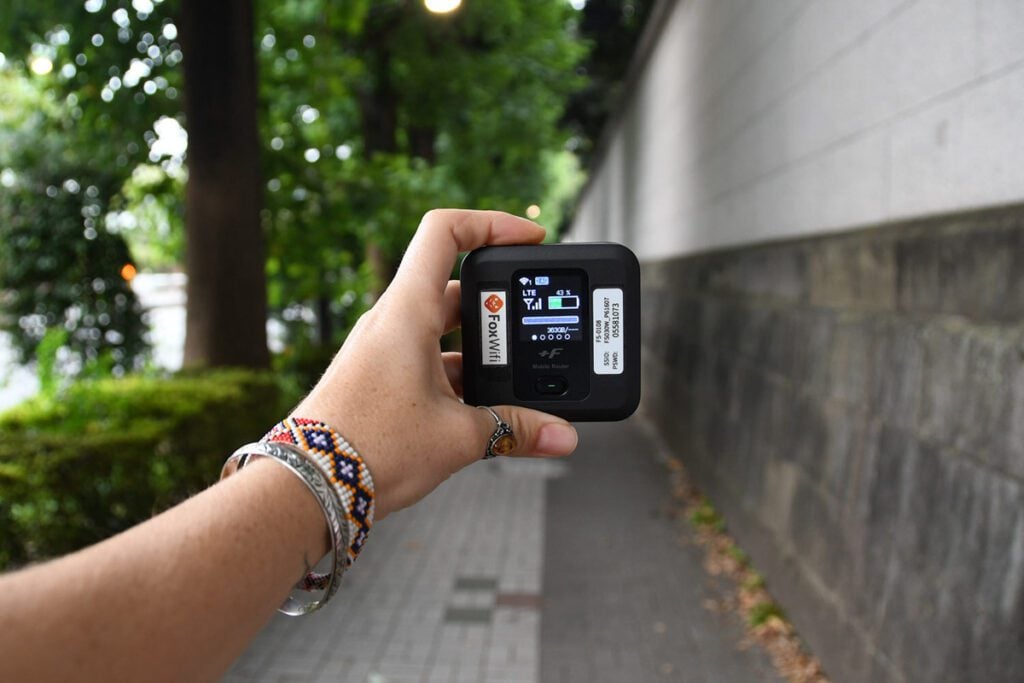
Staying connected to the Internet is very useful when traveling in Japan. And not just because you can post your pretty pictures to Instagram to make all your friends jealous…
Having an Internet connection will make your travels SO much easier when it comes to translating Japanese writing and getting directions for the notoriously confusing train and metro systems.
Trust me, having translating and navigating abilities in Japan is an absolute LIFESAVER.
The two best ways to stay connected is with a SIM card or via a hotspot. The best option is going to totally depend on your needs and budget, and we’ve compared them here so you can choose the best one for you.
27. Convenience store culture is a thing
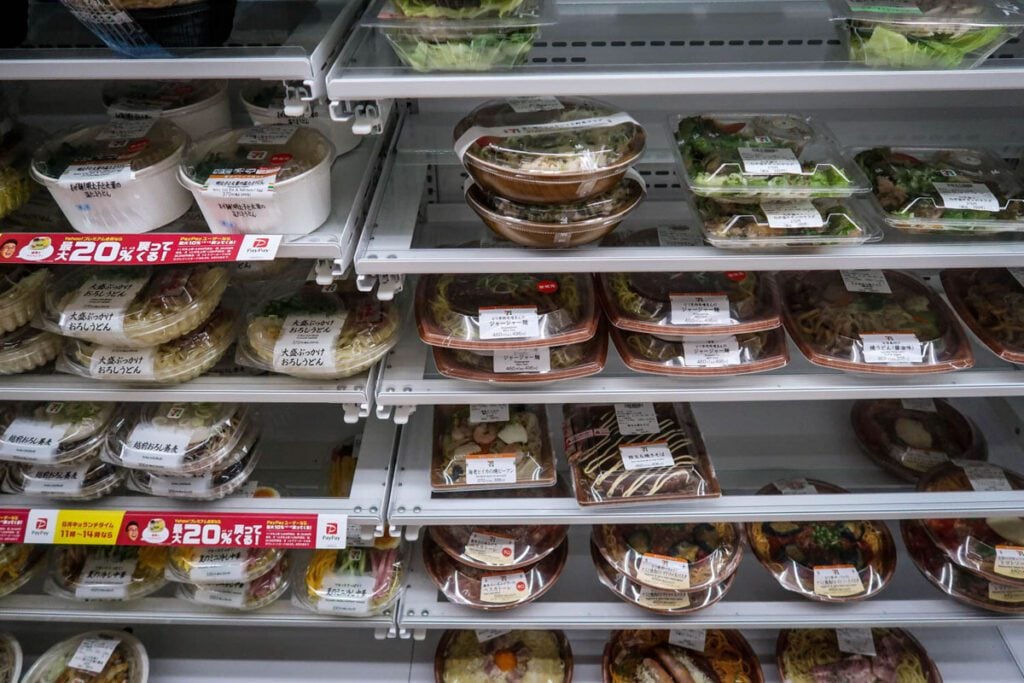
Convenience stores are a big deal in Japan.
And the food options in Japanese convenience stores are much larger — and less sketchy — than in most other places around the world. I mean, I would NEVER get sushi from a convenience store in the U.S., but I definitely did just that in Japan. And it was good!
You can literally eat breakfast, lunch, and dinner (and all your snacks too!) from convenience stores. The most popular chains are 7-Eleven, Lawsons, and Family Mart, and you can find them on just about every city block. No joke.
I will say that at the end of the day, the food you’ll find — while good — is still processed, packaged food. Some people claim they would live off of convenience store food in Japan. I am not one of those people!
I did enjoy it in moderation, and loved being able to try some super quirky treats, like Sugar Butter Sand Tree Cookies, which are weirdly delicious and familiar-tasting!
28. Don’t expect to eat lots of fresh fruits & veggies
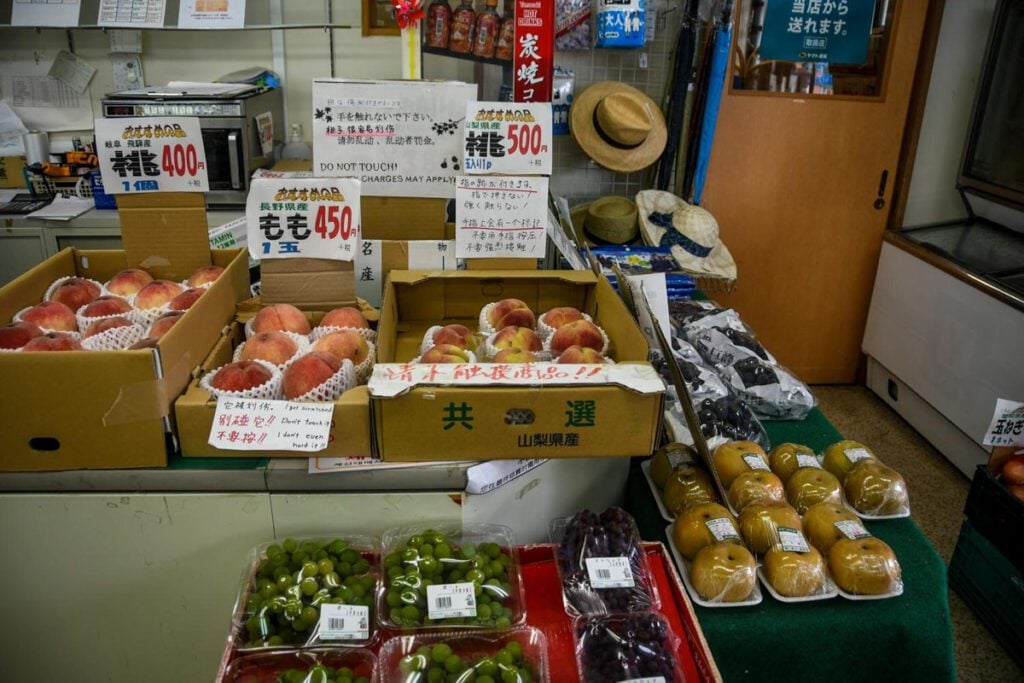
It might be good for some travelers to know that you should be prepared to go without a ton of fresh veggies and fruits for a while. We usually eat lots and lots of fresh vegetables and fruits, so we felt a bit “heavy/bloated” during our time in Japan.
You’ll find some vegetables cooked or fried in your meals or a shredded cabbage “salad” on the side, but not too much more than that. And fresh fruit is pretty expensive, so it’s more of a treat than a typical snack.
We had been living in Bali for 3 months before our trip to Japan, where our daily diet consisted of giant fresh salads and smoothie bowls. Let’s just say that Japan goes a lot heavier on the rice, noodles, meats and seafood than on fresh veg!
If you don’t eat that much fresh produce regularly, you might not notice too much of a difference.
Tip: Also, while convenience stores are great, and just that — super convenient! — I found it hard to find healthy snacking options. Next time I travel to Japan, I’ll pack some dried fruit (not covered in sugar), nuts, protein bars, etc.
29. Get a pre-paid transport card on the app
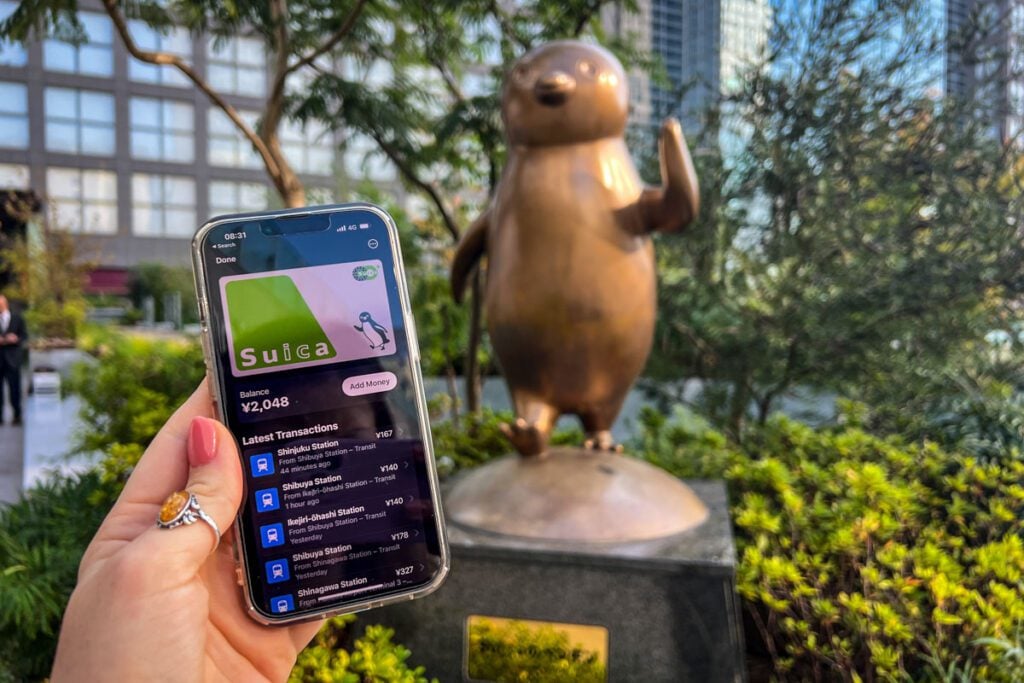
These are essentially the metro cards in Japan (Suica is for Tokyo and the surrounding area, and ICOCA is for Kyoto/Osaka and the greater Kansai region).
They will save you money on each trip, and are more convenient than having to purchase a ticket each time.
Due to a shortage of physical cards, you are now required to get an app on your phone. Simply tap on and off, eliminating the hassle of purchasing individual tickets. Note that Visa isn’t accepted, so rely on Apple Pay, Mastercard, or American Express for top-ups.
You can use your card for purchases in convenience stores, which is handy when you don’t have cash.
30. Do pack light for Japan
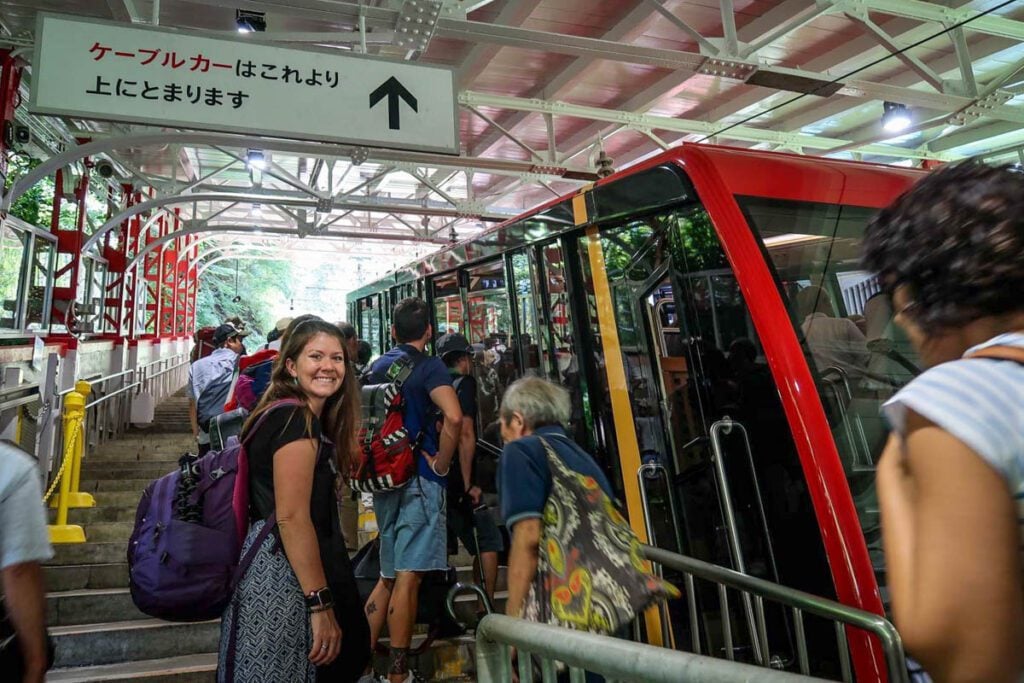
We actually broke this rule, as we had been living in Asia for a year and were in the midst of bringing all our stuff back to the U.S.
But trust me when I say that carrying big backpacks or suitcases through crowded metros, trains and intersections is NOT fun.
We found a luggage transfer service that was able to send the luggage we didn’t need from Osaka to our hotel in Tokyo and store it for us. It was super simple and cheap! I’m sure there are more services out there, but it was a little hard to find when we were searching.
Before you leave, check out these super helpful guides full of packing hacks and tips for traveling in Japan that you won’t find anywhere else:
- Our Japan packing guide lists all the essentials (many of which you might not think about), as well as what you should NOT pack for a trip to Japan.
- This article on what to wear in Japan will help you create a perfect capsule wardrobe for every season and let you in on some cultural taboos so you can be sure to dress appropriately.
- With this FREE Japan packing list PDF download, we’ll send checklists straight to your inbox for everything from clothing and toiletries (for both women and men!) to what shoes to pack and extra stuff you may want to have on-hand just in case. Click the image below to get your free copy!

31. Bring comfortable walking shoes
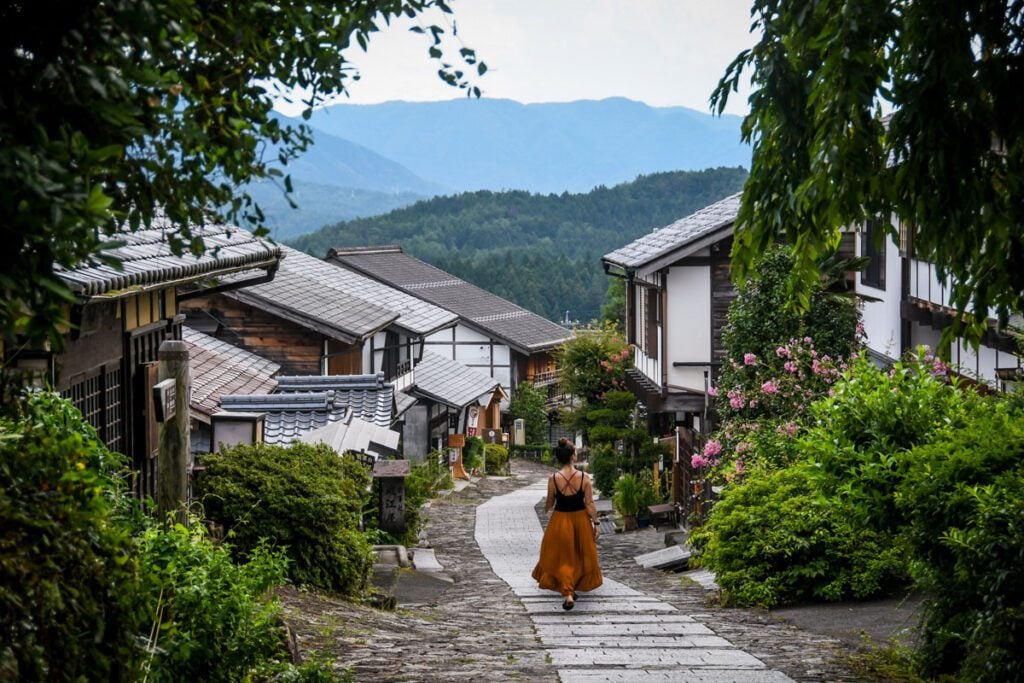
When people say you’ll be walking a lot in Japan, they ain’t lying! We walked an average of 10 miles (16 km) each day, so comfortable shoes are a MUST.
→ Psst! We have a list of must-see landmarks in Japan that’s sure to give you some inspiration for your itinerary!
32. Know about cover charges at Izakayas
Even though you’re not expected to pay gratuity in izakayas, it’s good to know that many establishments charge what’s called a otōshidai, or a “cover charge”.
Sometimes you’ll be given a small (aka TINY!) dish, otōshi, for which the charge is attributed on your bill. However, it’s really just an extra fee for the seat you are occupying.
Usually it’ll be between 200 – 500 yen. It’s good to expect this so you’re not confused when your final bill comes.
33. Don’t try to split one meal
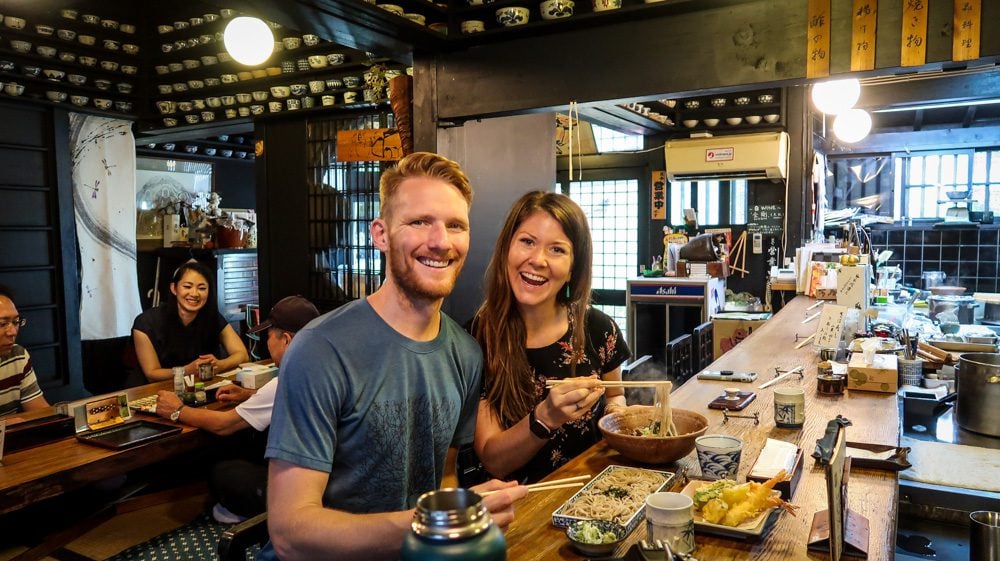
Sometimes when we’re traveling on a budget, we like to split one large meal. Often times, we don’t feel the need to order two full entrees, plus, it cuts our food costs in half.
However, this is usually considered rude in Japan since seating is often limited and you are taking up a spot in the restaurant.
So for instance, it would be frowned upon for two people to go into a ramen shop at a busy hour, and only order one bowl of soup to split between two people. If one party doesn’t feel like eating, it would be best to wait outside (I know, I know!).
An exception to this would be if you go at an off-hour, say 3 in the afternoon, when a restaurant is less busy. You can ask if it’s okay to split one meal.
We did this once at a restaurant where they served large seafood dishes. The restaurant was pretty much empty in the middle of the afternoon and we just wanted a light meal, not 2 huge entrees. They said it was fine, but I wouldn’t have done this at a busy time of day.
Note: When we say this, we don’t mean you can’t try each other’s meals — we did this ALL the time — and find it the best way to taste as many dishes as possible.
34. Know you can’t see/do everything…
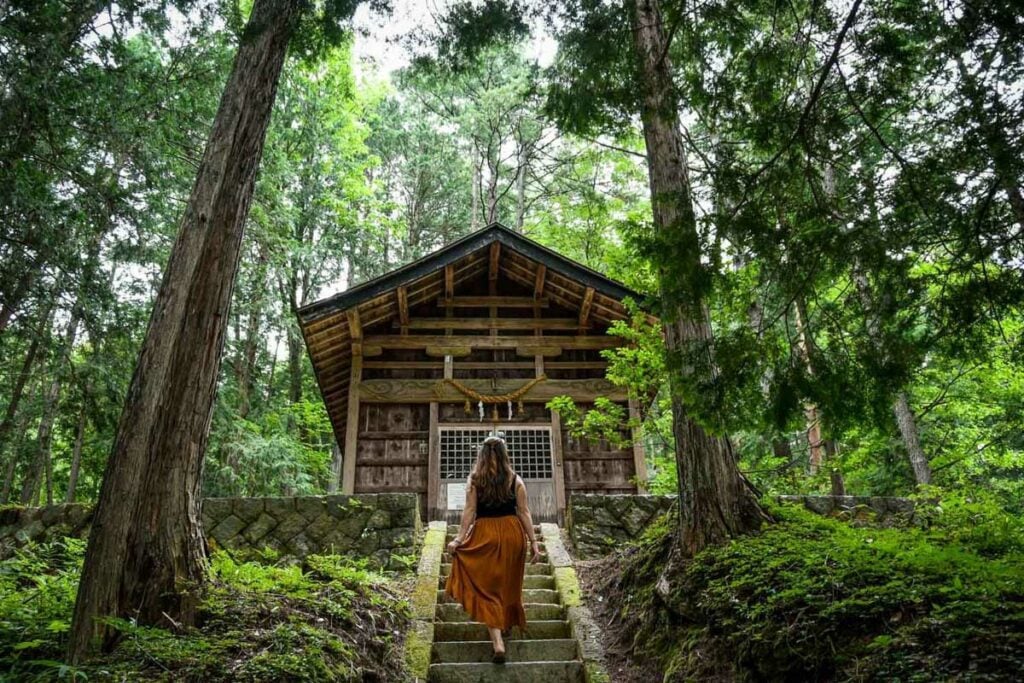
This can be a hard one to come to terms with, especially when you see all sorts of posts and advice. It can honestly get overwhelming (been there!). Just know that you’ll need to narrow down and prioritize the things you really want to do.
If you don’t get to everything — you likely won’t, there are ENDLESS cool things to do in Japan — you can always come back for a second, third, seventh visit down the road.
→Need help deciding how long to plan your trip for? Our guide to how many days to spend in Japan will help you figure out how much time you need based on what you want to do.
35. Planning is your friend in Japan

We usually love to travel with a lot of room for flexibility. However, unless you’ve got a lot of time to travel around Japan, planning your route and accommodation in advance is going to help you maximize your time.
Add in some “flexible” time where you can just wander or relax, but our advice would be to come with a pretty solid plan (even if you don’t usually travel this way).
Be sure to check out our ultimate Japan planning guide to help prepare for your trip!
Plan your trip to Japan
After 3 trips (and counting!), we’ve fallen head over heels for Japan—and we’ve created TONS of resources to help you plan your dream trip. Start with our Ultimate Japan Travel Guide and be sure to check out these helpful articles:
- First time? Our Japan Trip Planner walks you through everything you need to know.
- Use our Japan Rail Pass guide to determine if getting a train pass is optimal for your trip.
- Here’s our curated list of the best things to do in Japan—from iconic sights to once-in-a-lifetime experiences.
- Not sure where to go? Our Japan itinerary ideas will help you map it all out.
- Foodies, rejoice! This guide to what to eat in Japan will have you drooling before you land.
- This guide to what to wear in Japan (and what not to wear) will help you blend in.
- Use our ultimate Japan Packing List to make sure you don’t forget anything.
- Avoid awkward moments by brushing up on Japanese etiquette.
Still have questions? Drop us a comment—we LOVE helping travelers plan unforgettable trips to Japan!
Perfect Japan itinerary
Want the perfect itinerary planned for you?

If you don’t have a ton of time to spend planning your Japan itinerary (or you just don’t find travel planning fun), we’ve got something you might be interested in…
We created the ultimate done-for-you Japan itinerary that is packed full of all sorts of tips we’ve gathered from 3 trips to Japan as well as literally hundreds of hours of research (no exaggeration).
We have both an off-the-beaten path route as well as a classic itinerary that hits the top attractions (perfect for your first visit to Japan!).
Don’t miss your chance to grab our Japan Pocket Guide!
This (totally FREE!) pocket guide is a condensed version of all the things you should know BEFORE & DURING your trip to Japan!
Just enter your email and we’ll immediately send our pocket guide straight to your inbox!
Save this article to Pinterest for later!
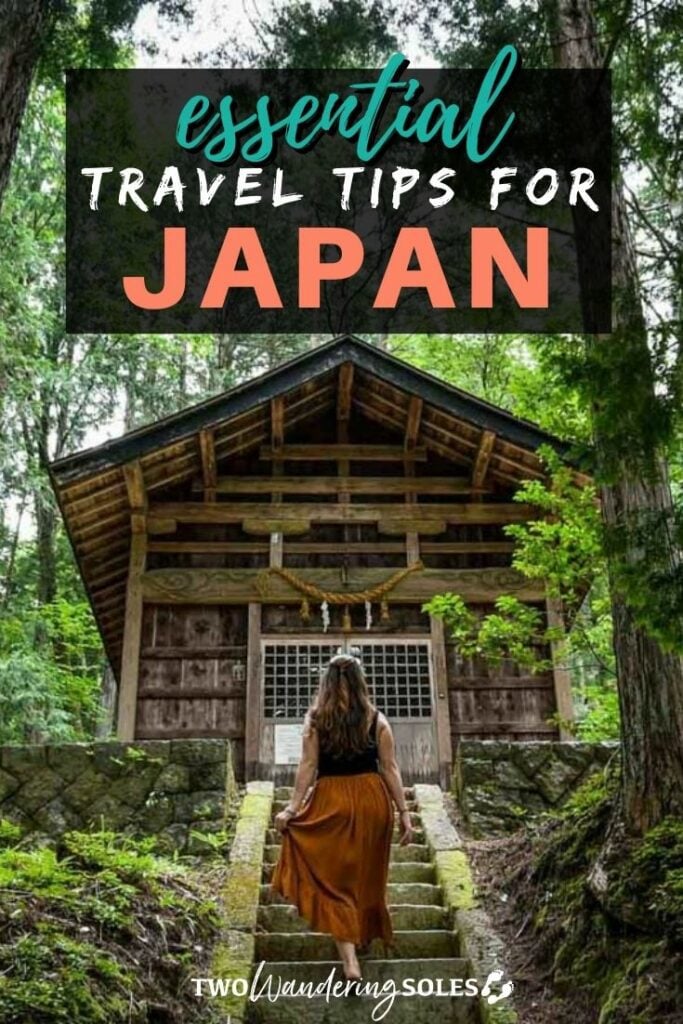
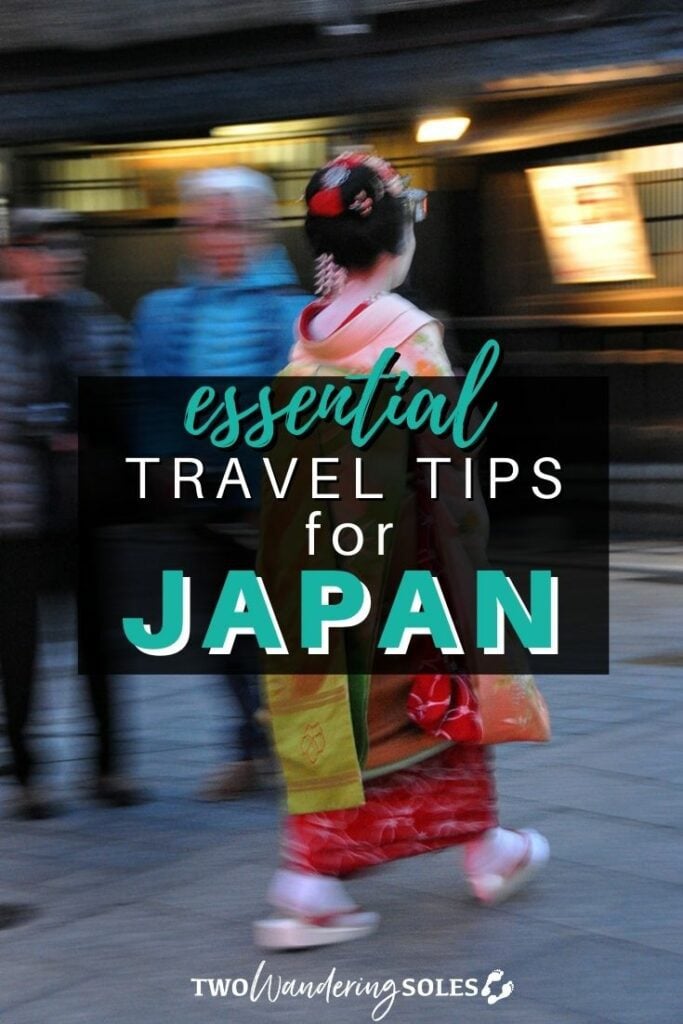
We want to hear from you!
Are any of these tips for visiting Japan surprising to you? Do you have any more Japan travel tips you think we missed? Let us know in the comments below!

